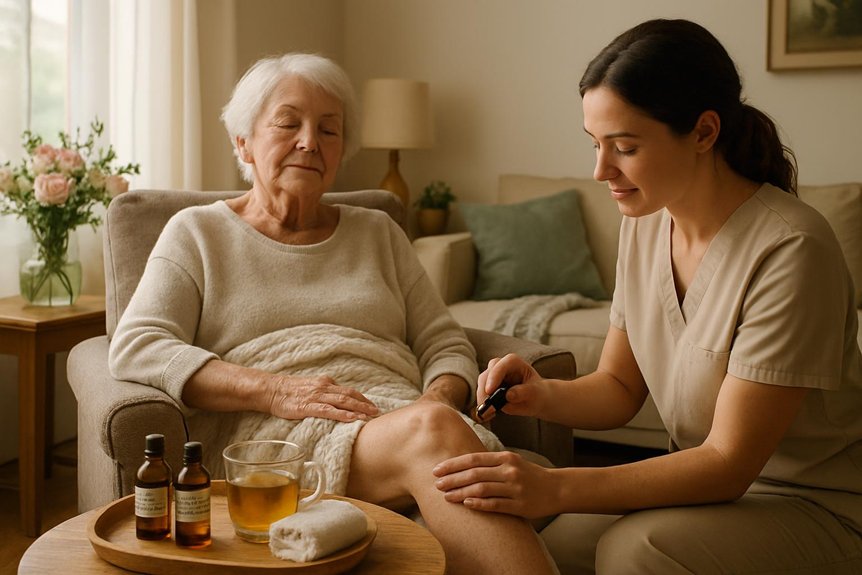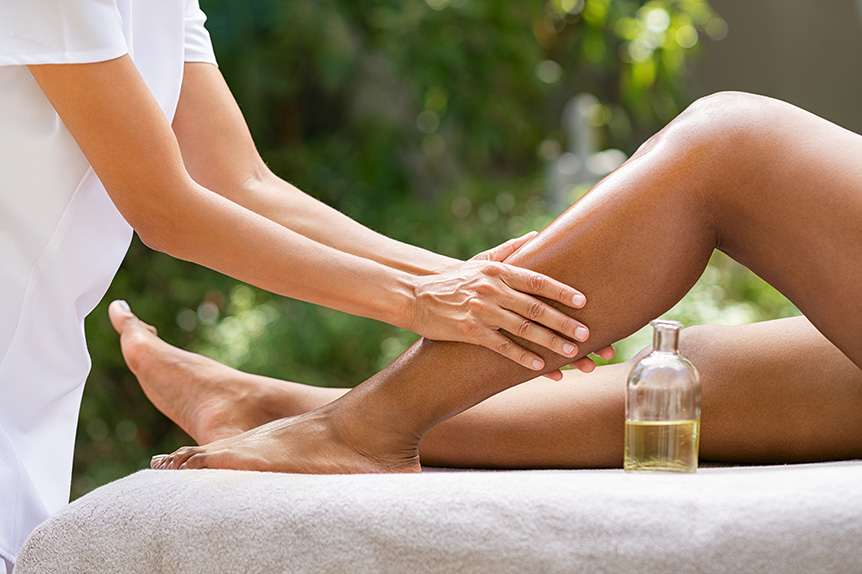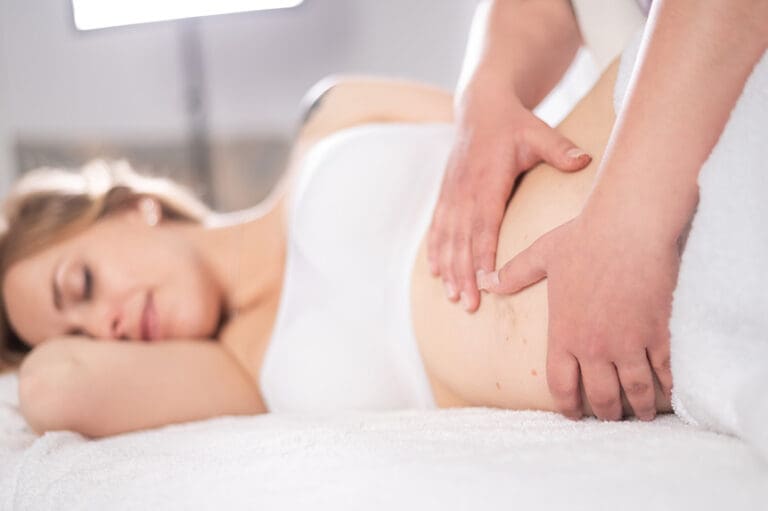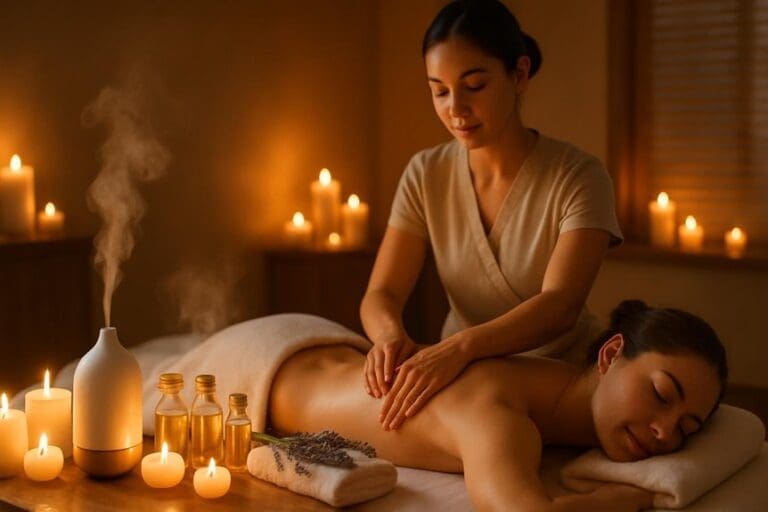This may ease osteoarthritis symptoms by modulating nociceptive signaling, calming dorsal horn input, and reducing sympathetic tone. Gentle effleurage and slow, low‑load strokes can lower capsular tension, distribute synovial fluid, and decrease co‑contraction. Essential oils like lavender, ginger, and rosemary (1–3% dilution) show small‑trial benefits for short‑term pain and stiffness, likely via limbic and local anti‑inflammatory effects. It is an adjunct, not a cure, with safety screening essential. Further details clarify techniques, oil choices, and precautions.
Understanding Osteoarthritis and Joint Pain

How does osteoarthritis generate joint pain? Progressive cartilage erosion exposes subchondral bone, increasing mechanical stress and microfractures. The joint responds with synovial inflammation, releasing cytokines such as IL-1β and TNF-α that sensitize nociceptors.
Osteophyte formation, capsular thickening, and joint effusion elevate intra-articular pressure, provoking a deep, activity-linked ache and morning stiffness. Peripheral sensitization extends to central pathways, amplifying pain beyond structural change.
Muscular co-contraction around the joint—often a protective reflex—further restricts movement and feeds a cycle of pain and guarding.
From Spa & Massage’s clinical perspective in London, clients commonly describe fluctuating flares tied to load, weather shifts, and sleep quality. Understanding these mechanisms guides gentle, symptom-aware care, pacing strategies, and touch that respects inflamed tissue while supporting comfort, circulation, and calmer pain signalling. Additionally, some clients with osteoarthritis may find therapeutic benefits through deep tissue massage, which can assist in reducing muscular tension and improving overall joint mobility.
What Aromatherapy Massage Involves
For osteoarthritis typically applies gentle, graded pressure and slow effleurage to modulate nociception, reduce periarticular muscle guarding, and support synovial fluid dynamics without provoking inflammatory flare.
Essential oils are selected for safety and plausible mechanisms—such as lavender or chamomile for autonomic downregulation and perceived pain reduction—using dermal-safe dilutions as practiced at Spa & Massage.
A standard session at our London clinics includes brief assessment, targeted manual techniques, and post-session guidance on hydration, joint-friendly movement, and skin monitoring to optimise analgesic carryover and minimise irritation.
Gentle Pressure Techniques
In clinical practice at Spa & Massage, gentle-pressure aromatic massage for osteoarthritis prioritises low-load, slow-stroke techniques that modulate nociception and reduce periarticular muscle guarding without provoking joint irritation.
Therapists maintain pressures within pain-free thresholds, using effleurage and light kneading to enhance superficial circulation, facilitate lymphatic clearance, and downregulate dorsal horn sensitisation via A‑beta mechanoreceptor input.
Strokes follow the muscle fibres surrounding affected joints—quadriceps, hamstrings, calf, forearm flexors/extensors—avoiding direct compression of inflamed joint lines.
Sustained holds over myofascial trigger bands are applied at sub-pain intensity, allowing viscoelastic creep and sympathetic quieting, which many clients experience as soothing warmth and ease.
Joint-adjacent skin stretching and fascial glides reduce cutaneous allodynia and improve proprioceptive feedback.
In our London clinics, session pacing is slow, breath-synchronised, and continuously reassessed to maintain comfort while encouraging gentle mobility gains.
Essential Oil Selection
Several essential oils are selected based on mechanistic plausibility for nociceptive modulation, local anti-inflammatory potential, and autonomic regulation relevant to osteoarthritis.
In Spa & Massage clinics, therapists favour lavender (linalool/linalyl acetate) for central down‑regulation of pain signalling and parasympathetic shift; sweet marjoram for gamma‑aminobutyric tone; and frankincense (boswellic acids) for COX‑2 and 5‑LOX inhibition.
Ginger and black pepper are used for TRPV1/TRPA1 desensitisation and microcirculatory warming, while rosemary cineole supports descending inhibition and mild anti‑inflammatory effects.
Chamomile (alpha‑bisabolol) is chosen for localized prostaglandin modulation and skin tolerance.
All are diluted to skin‑safe concentrations (typically 1–3%) in neutral carriers to optimise percutaneous absorption and barrier integrity.
Our therapists screen for sensitivities, medications, and joint flare status, then blend selectively to complement gentle pressure protocols.
Session Flow and Aftercare
Before manual contact, a brief triage confirms joint status (pain intensity, swelling, heat), medications, allergies, and functional goals. This is followed by baseline range‑of‑motion and pain mapping to target symptomatic compartments (e.g., medial tibiofemoral, first CMC).
At Spa & Massage, therapists then select a carrier blend and low‑irritant essential oils aligned to inflammatory load and central sensitisation risk. The session proceeds with gentle effleurage to warm tissues, then graded pressure along periarticular soft tissues, avoiding direct compression on osteophytes or inflamed bursae.
Slow joint‑line holds and lymph‑directed strokes address effusion and nociceptive drive. diaphragmatic breathing cues down‑regulate autonomic arousal.
Aftercare includes hydration, 24‑hour heat moderation, light active range‑of‑motion, and pacing. Therapists advise dose titration: shorter intervals if flares, longer if morning stiffness predominates.
Clients receive home aromatherapy guidance when appropriate.
How Essential Oils May Support Osteoarthritis Symptoms

Why consider essential oils alongside standard care for osteoarthritis? They may modulate pain signaling and local inflammation when used with massage.
In Spa & Massage clinics, therapists select oils based on putative mechanisms: lavender and sweet marjoram to support parasympathetic tone and reduce muscle guarding; rosemary or black pepper to encourage local circulation and warmth; frankincense to target nociceptive sensitivity; ginger to influence COX-mediated pathways.
Blended in skin-safe dilutions, topical application with slow, compressive strokes may reduce joint-related hyperalgesia by easing periarticular muscle tension, improving tissue glide, and supporting lymphatic clearance.
Their approach is pragmatic: oils are adjuncts, not cures. Clients are guided to monitor skin tolerance, medication interactions, and symptom patterns, aligning aromatherapy with exercise, weight management, and clinician-led care.
Evidence and Research on Aromatherapy for Joint Health
How robust is the evidence base for aromatherapy in joint health? Current data suggest modest, short‑term benefits when aromatherapy oils are combined with structured massage. Small randomized trials in knee osteoarthritis report reductions in pain scores and morning stiffness over 2–8 weeks, especially with lavender, ginger, and rosemary.
Though effects are observed, they often wane after discontinuation. Proposed mechanisms include transient modulation of nociception via limbic pathways, reduced sympathetic tone, and local anti‑inflammatory actions (e.g., downregulation of COX‑2, TNF‑α) from selected terpenes.
Methodological limitations—small samples, variable oil chemotypes, inadequate blinding, and heterogeneous protocols—temper confidence in these findings.
Spa & Massage aligns practice with this evidence: standardized dilution, controlled stroke pressure, and consistent session frequency. They position aromatic massage as an adjunct to guideline‑based osteoarthritis care and emphasize monitoring functional goals.
Benefits You Might Notice After Sessions
Following aromatic massage, individuals with osteoarthritis commonly report short-term reductions in nociceptive pain, diminished morning stiffness, and improved joint ease of movement. These effects likely reflect transient decreases in peripheral sensitisation, gentle inhibition of muscle guarding around affected joints, and autonomic down-regulation that lowers sympathetic drive.
When botanical oils are paired with slow, graded pressure, local cutaneous stimulation may modulate dorsal horn signalling, while warmth and glide encourage synovial fluid distribution, easing capsular tension.
Clients at Spa & Massage also describe a calmer mood and easier sleep the night after treatment—changes consistent with reduced cortisol and improved parasympathetic tone. Our therapists observe small but meaningful gains in comfortable range, better gait fluidity, and less protective co-contraction.
Repeated sessions often consolidate these functional improvements, supporting everyday tasks with quieter joints.
Safety Considerations and Who Should Avoid Certain Oils
Although aromatic massage is generally well tolerated in osteoarthritis, safety hinges on understanding dermal sensitisation, systemic absorption, and co‑morbid risk.
Essential oils can disrupt the stratum corneum, provoke allergic contact dermatitis, or trigger phototoxicity (e.g., cold‑pressed citrus).
Transdermal absorption remains low but may matter in pregnancy, lactation, epilepsy, anticoagulation, uncontrolled hypertension, asthma, and significant hepatic or renal impairment.
Those with ragweed allergy should avoid chamomile; salicylate sensitivity warrants caution with wintergreen; estrogen‑sensitive conditions should avoid clary sage and fennel; latex allergy may cross‑react with ylang‑ylang.
In Spa & Massage clinics, therapists dilute to 1–2%, avoid sensitising oils on compromised skin, and patch‑test when histories are complex.
They recommend fragrance‑free carrier oils for eczematous flares, and refrain from oils pre‑surgery or with new anticoagulants.
What a Session at Spa & Massage Typically Looks Like
Risk mitigation shapes the structure of an aromatic massage for osteoarthritis at Spa & Massage: therapists operationalise safety screening into a stepwise session.
On arrival, a concise musculoskeletal history targets joint distribution, morning stiffness, red flags, anticoagulant use, and skin sensitivities.
Blood-pressure check and pain mapping define tolerable load.
Patch testing precedes oil selection; in our clinics, diluted lavender, ginger, or frankincense are typical choices when appropriate.
Positioning prioritises joint protection—bolsters unload knees and hips, neutral heat is applied away from inflamed synovium.
Strokes progress from light effleurage to graded, slow myofascial work around periarticular tissues, avoiding direct compression over osteophytes or acutely swollen joints.
Rhythm is unhurried to downregulate nociception and sympathetic tone.
Session endpoints reassess range, pain scores, and gait comfort, with clear guidance on expected transient soreness and thresholds for concern.
Home Care Tips to Extend the Benefits

How can post-session behaviours preserve analgesia and joint ease after aromatic massage for osteoarthritis? Spa & Massage advises clients to protect the neuromodulatory gains achieved in-session. Hydration supports synovial fluid turnover and lymphatic clearance of inflammatory mediators.
Gentle heat (20–30 minutes) to affected joints sustains vasodilation initiated by massage, reducing nociceptor sensitisation. Our therapists recommend low-load, pain-free range-of-motion drills within two hours post-treatment to consolidate viscoelastic lengthening of periarticular tissues.
In our clinics, clients are counselled to avoid high-impact activity for 24 hours to prevent reactive muscle guarding. Evening self-application of diluted lavender or sweet marjoram (1–2%) over joints can extend parasympathetic tone and dampen central pain gain.
Prioritising sleep hygiene stabilises cortisol rhythms, supporting overnight tissue recovery.
Choosing the Right Treatment Plan With Our Therapists
An individualised plan for aromatic massage in osteoarthritis begins with a structured assessment by Spa & Massage therapists, integrating symptom mapping, joint-specific impairment, pain chronotype, and comorbidity screening.
This maps nociceptive drivers—synovitis, capsular stiffness, myofascial guarding—and clarifies loading tolerance. In our clinics, oil selection aligns with goals: lavender or chamomile to modulate central arousal, rosemary for perceived stiffness, ginger for local warmth. Techniques are dosed: gentle effleurage during flare, progressing to rhythmical petrissage and joint-adjacent myofascial work as irritability falls.
Session frequency typically begins 1–2 times weekly for 2–4 weeks, then tapers. Therapists coordinate with existing medical care, monitor red flags, and adapt for anticoagulants, neuropathy, or skin sensitivity.
Clear goals—sleep continuity, morning stiffness minutes, sit-to-stand ease—guide progress and keep care intimate, steady, and safe.
Conclusion
In brief, aromatic massage can complement osteoarthritis care by modulating nociception, reducing periarticular muscle guarding, and improving sleep—factors that amplify central sensitization. Evidence remains modest but promising; a meta-analysis reports small-to-moderate pain reductions (standardized mean difference ≈ −0.30). At Spa & Massage, tailored pressure, joint-friendly positioning, and low-irritant oils (lavender, chamomile, ginger) prioritize safety and symptom control. While it does not halt cartilage degeneration, regular sessions may enhance function and perceived quality of life when integrated with exercise, analgesics, and weight management.



